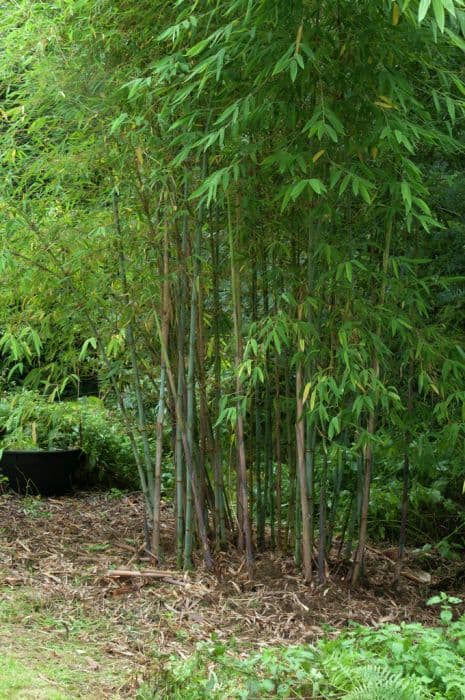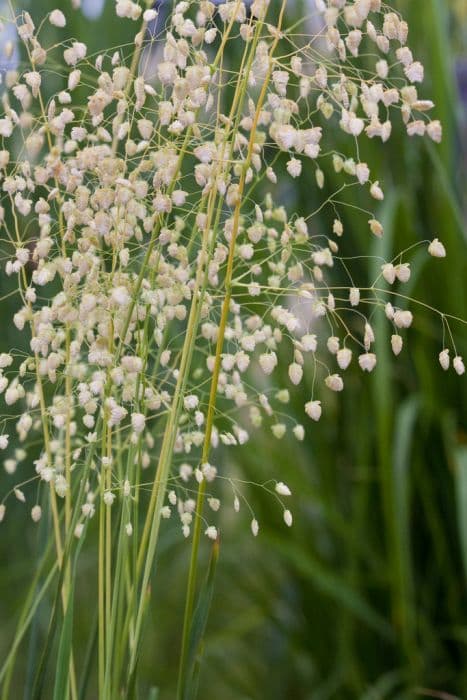Maiden Grass Miscanthus sinensis 'Ferner Osten'

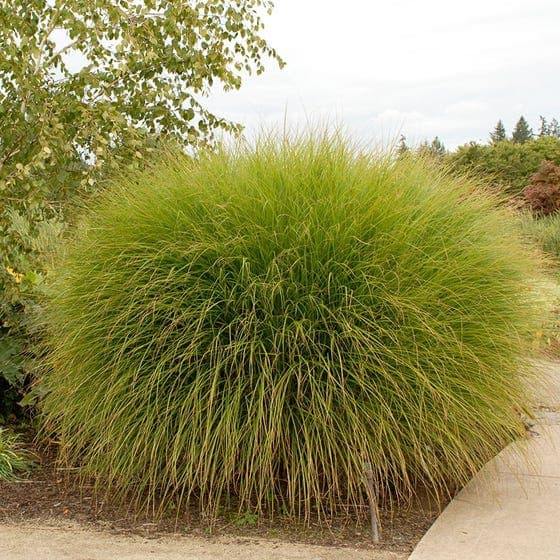
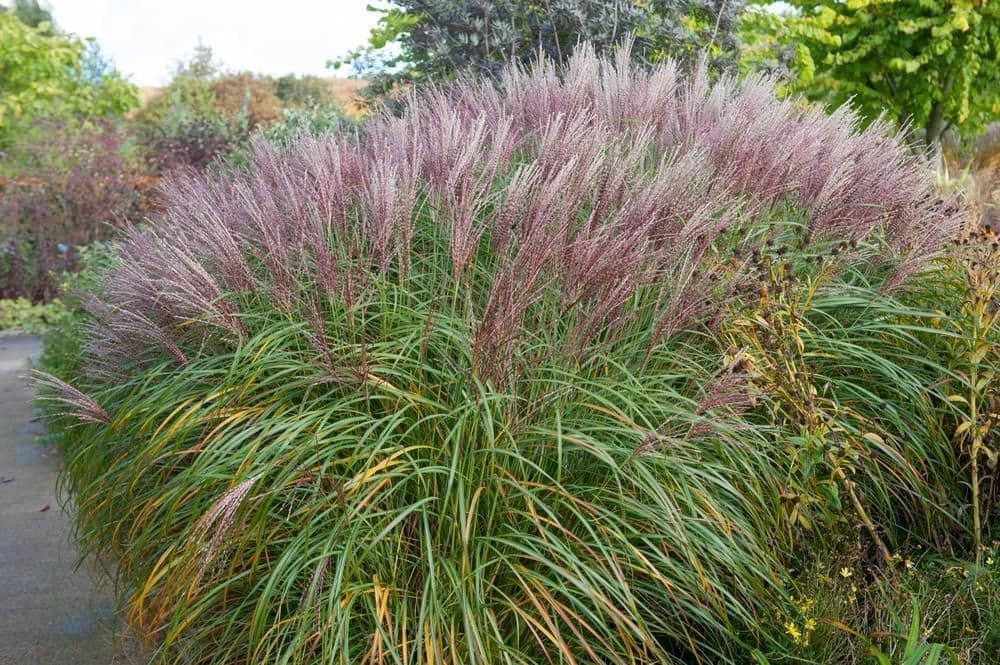

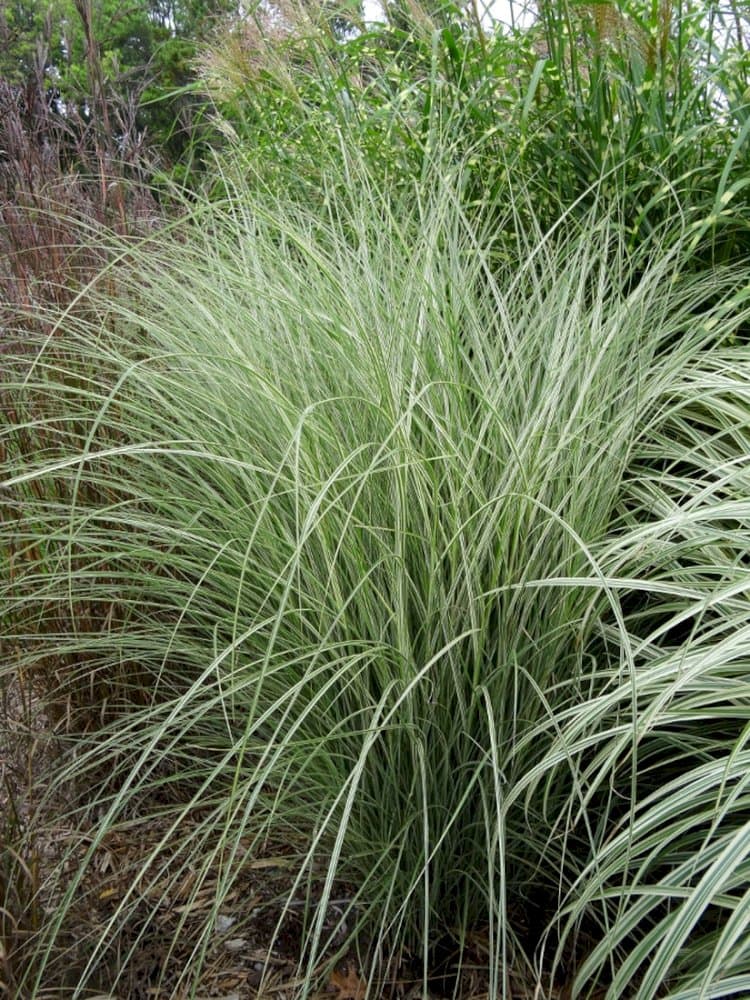
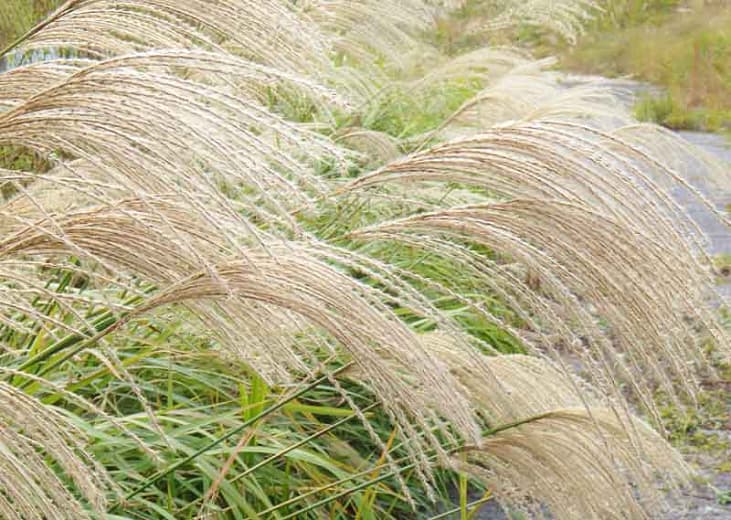
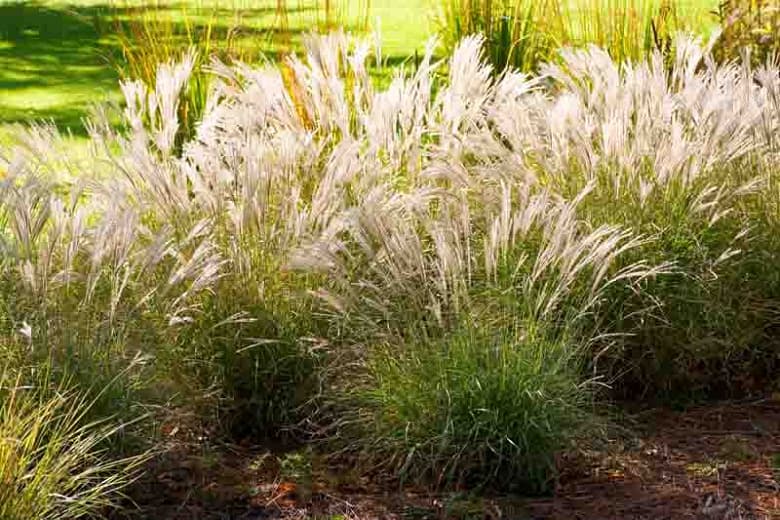

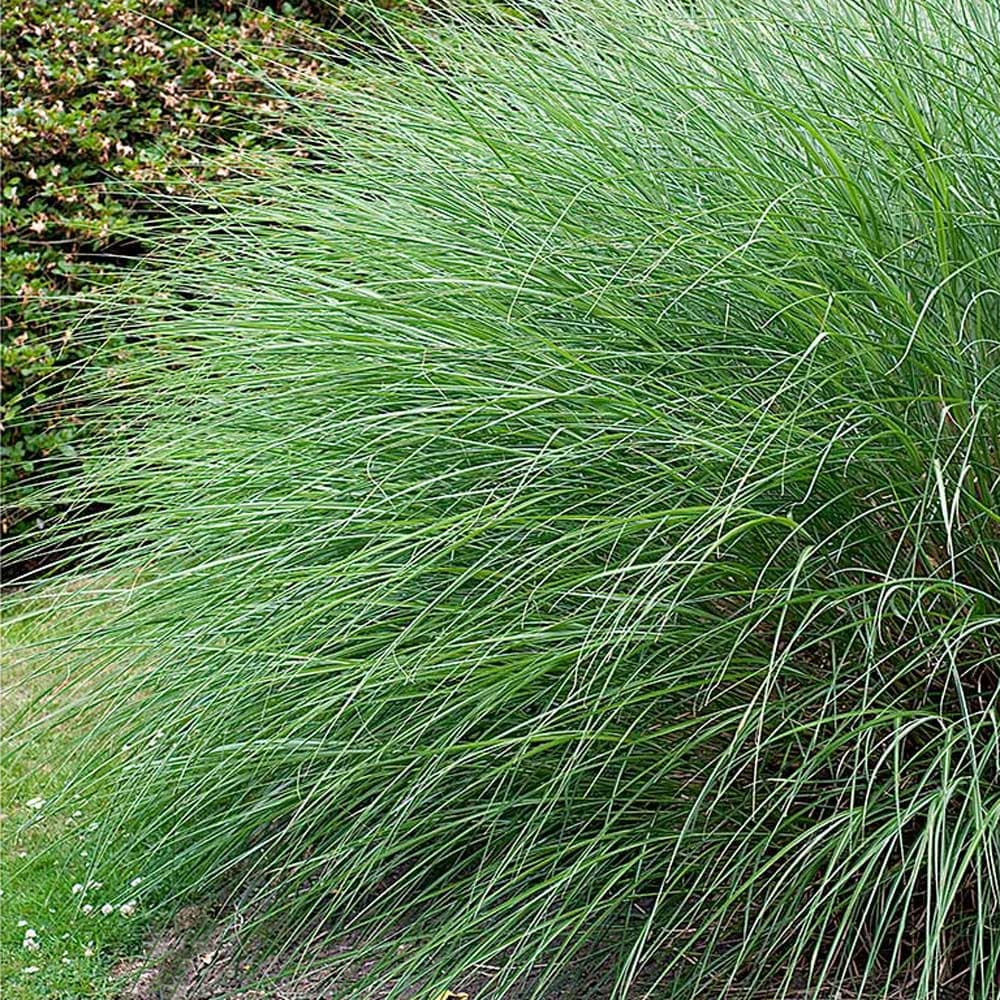
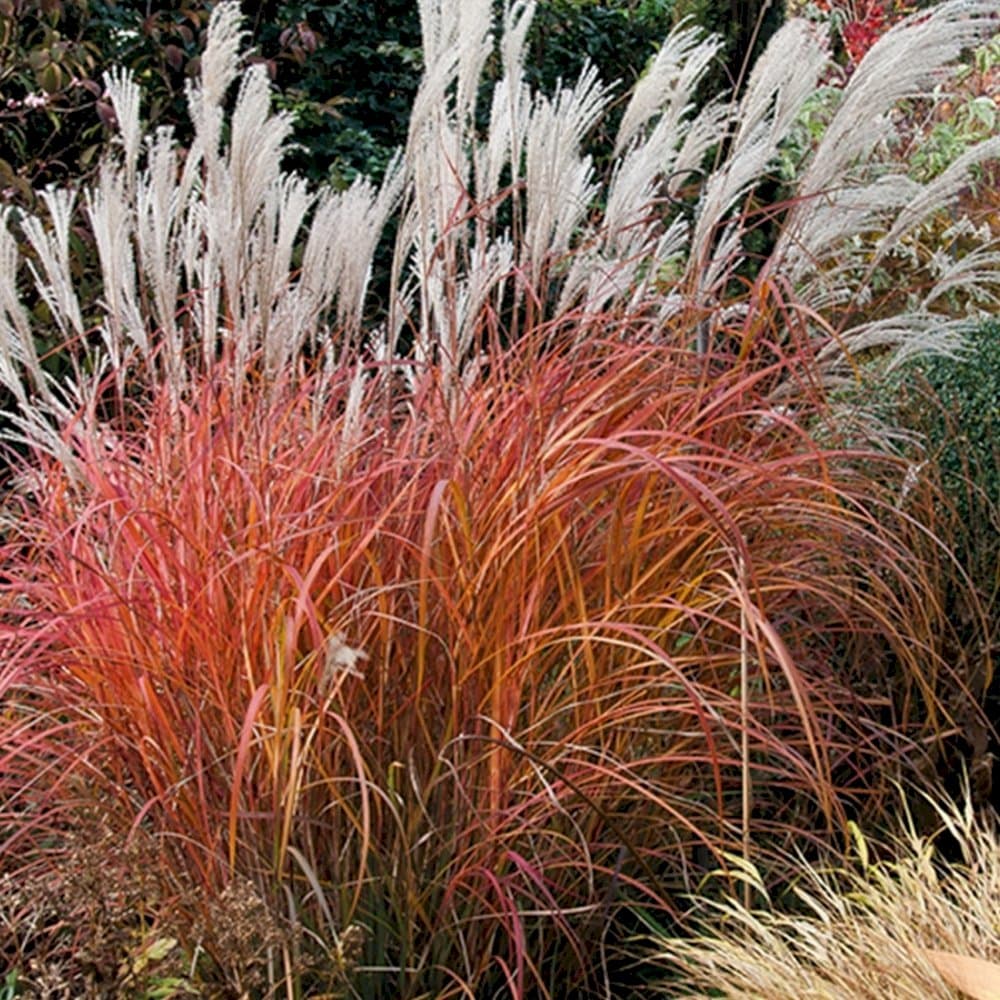
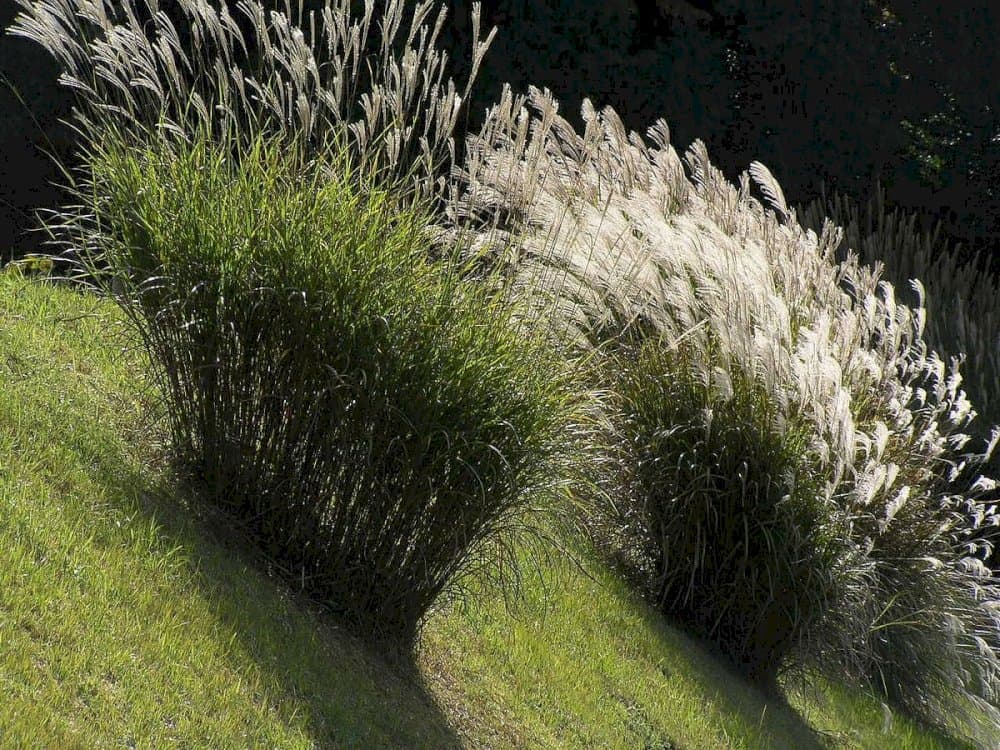
ABOUT
The plant commonly known as Maiden Grass 'Ferner Osten' is a perennial grass that is appreciated for its ornamental qualities. It features a clump of narrow, arching leaves that present in a vibrant green during the growing season. As the seasons progress, the foliage may transition to exhibit autumnal shades, often taking on hues of orange, red, or gold, adding a warm and inviting color palette to the garden landscape. Come late summer or early fall, this grass produces feathery flower plumes that rise slightly above the foliage. These plumes start off with a reddish tint and eventually fade to a silvery color, providing a delicate and airy visual effect. As the seeds mature, they turn into fluffy, silver-white tufts that catch the light and can add a sparkling touch to the garden, especially when backlit by the early morning or late afternoon sun. The texture of Maiden Grass 'Ferner Osten' is fine and graceful, contributing to its use in gardens for adding movement and depth, as the leaves and plumes sway elegantly in the breeze. Over the course of the year, this plant offers a dynamic range of visual interest, making it a favorite for both gardeners and landscapers seeking to create an alluring and ever-changing garden scene.
About this plant
 Names
NamesFamily
Poaceae
Synonyms
Chinese Silver Grass, Eulalia, Maiden Grass, Zebra Grass, Porcupine Grass
Common names
Miscanthus sinensis 'Ferner Osten'.
 Toxicity
ToxicityTo humans
Maidenhair grass is not known to be toxic to humans. It is considered a non-poisonous ornamental grass. Therefore, there are no specific symptoms associated with poisoning from this plant because it is not expected to produce adverse effects if ingested by humans.
To pets
Maidenhair grass is also not known to be toxic to pets. It is regarded as a safe ornamental grass when it comes to pet health, and there should be no symptoms of poisoning in pets that ingest this plant. Consequently, there are no specific toxicity concerns or consequences associated with pets ingesting any part of this plant.
 Characteristics
CharacteristicsLife cycle
Perennials
Foliage type
Deciduous
Color of leaves
Green
Flower color
Red
Height
4 feet (1.2 meters)
Spread
3 feet (0.9 meters)
Plant type
Grass
Hardiness zones
5
Native area
Asia
Benefits
 General Benefits
General Benefits- Ornamental Value: Miscanthus sinensis 'Ferner Osten', commonly known as Maiden Grass, adds aesthetic appeal to gardens with its fine-textured foliage and spectacular reddish flower plumes.
- Seasonal Interest: Maiden Grass provides visual interest throughout multiple seasons, starting with green foliage in spring, transitioning to flowers in late summer and then tall, dry stems in autumn and winter.
- Wildlife Attraction: The grass can attract birds, which feed on its seeds and use the plant as shelter.
- Drought Tolerance: Once established, Maiden Grass is quite drought-resistant, making it suitable for xeriscaping and reducing the need for frequent watering.
- Erosion Control: The dense root system of Maiden Grass helps stabilize the soil, making it an excellent choice for slope stabilization and erosion control.
- Low Maintenance: Maiden Grass requires minimal care once established, needing only occasional division and yearly trimming before new growth starts.
- Privacy Screen: Due to its tall and dense growth habit, Maiden Grass can be used as a natural garden screen or privacy barrier when planted in groups.
- Adaptability: It can thrive in a variety of soil types, ranging from clay to sandy soils, as long as they provide good drainage.
- Winter Interest: Even in winter, the dried stalks and flower heads provide texture and movement to otherwise barren landscapes.
- Versatility: Maiden Grass works well in mixed borders, as a focal point in garden designs, and in mass plantings, offering designers and gardeners versatility in its use.
 Medical Properties
Medical PropertiesThis plant is not used for medical purposes.
 Air-purifying Qualities
Air-purifying QualitiesThis plant is not specifically known for air purifying qualities.
 Other Uses
Other Uses- Miscanthus sinensis 'Ferner Osten', commonly known as Maiden Grass, can be used as a sound barrier due to its dense foliage, which helps to absorb and reduce noise pollution.
- The tall and sturdy stalks of Maiden Grass can be utilized for making natural garden stakes to support other plants.
- When dried, the elegant plumes of Maiden Grass are popularly used in floral arrangements and as a long-lasting decoration.
- The fibrous material of the plant has been explored for paper-making, providing an alternative to traditional wood pulp.
- Miscanthus sinensis 'Ferner Osten' can be planted on slopes or banks for erosion control to help stabilize soil and prevent landslides.
- The dense growth habit of Maiden Grass makes it suitable for creating privacy screens in gardens and landscapes.
- The species is being researched as a biofuel source due to its high biomass production and low input requirements.
- Maiden Grass is occasionally used in thatched roofing constructions for its durability and insulation properties.
- Researchers are investigating the potential use of Miscanthus sinensis as a phytoremediation plant to remove heavy metals and other pollutants from contaminated soils.
- The tall stature of Maiden Grass can be effective as a windbreak, reducing wind speed and protecting more sensitive plants in a garden setting.
Interesting Facts
 Feng Shui
Feng ShuiChinese Silver Grass is not used in Feng Shui practice.
 Zodiac Sign Compitability
Zodiac Sign CompitabilityChinese Silver Grass is not used in astrology practice.
 Plant Symbolism
Plant Symbolism- Resilience: Miscanthus sinensis 'Ferner Osten', commonly known as Chinese silver grass, often symbolizes resilience since it can thrive in a wide range of conditions and displays robust growth.
- Adaptability: This plant's ability to adapt to various soil types and climates represents flexibility and the capacity to adjust to different situations in life.
- Elegance: With its fine-textured foliage and graceful plumes, Chinese silver grass is often associated with elegance and beauty, mirroring the aesthetic grace of life's gentle flow.
- Privacy: Because it can form dense clumps that are often used to create natural screens, it also symbolizes a need for privacy and personal space.
- Transition: As the plant transforms in appearance through the seasons, it is sometimes viewed as a symbol of life's transitions and the passage of time.
- Growth and Progress: The fast growth and upward habit of Chinese silver grass can represent personal growth and progression towards one's goals.
 Water
WaterThe Maiden Grass 'Ferner Osten' should be watered deeply until the soil is moist to a depth of several inches, which typically means using about 1 to 1.5 gallons of water for an established plant. During the first growing season, ensure consistent moisture to establish a deep, extensive root system, watering at least once a week in the absence of rainfall. Once established, the Maiden Grass is more drought-tolerant and may only need water every two to three weeks, depending on weather conditions. In periods of extreme heat or drought, increase watering frequency, but always allow the soil to dry out between watering to prevent root rot.
 Light
LightMaiden Grass 'Ferner Osten' thrives in full sun, requiring at least six hours of direct sunlight each day to develop its full potential in terms of growth and fall coloration. An ideal spot would be in an open area of the garden, possibly as a specimen plant where the sunlight can illuminate its feathery blooms and highlight the plant's autumnal hues.
 Temperature
TemperatureMaiden Grass 'Ferner Osten' is versatile and hardy, tolerating a range of temperatures, from as low as around -20°F to as high as 90°F. The ideal temperature conditions for this plant generally fall between 60°F and 75°F for optimal growth and plume production. It's hardy in USDA zones 5 through 9, enduring typical winters in these regions without significant protection.
 Pruning
PruningMaiden Grass 'Ferner Osten' should be pruned to remove dead foliage and promote new growth, typically done in late winter or early spring before new shoots appear. Cut the entire grass clump down to about 4 to 6 inches from the ground annually. Pruning is also an opportunity to shape the plant and encourage a lush, full appearance for the coming season.
 Cleaning
CleaningAs needed
 Soil
SoilMaidenhair Grass requires well-draining soil with a mix of compost for fertility. The ideal pH range for Miscanthus sinensis 'Ferner Osten' is slightly acidic to neutral, around 5.5 to 7.0. A blend of garden soil, peat moss, and perlite would make a suitable soil mix for this ornamental grass to thrive.
 Repotting
RepottingMaidenhair Grass, being a large perennial, does not require frequent repotting. Miscanthus sinensis 'Ferner Osten' should be repotted or divided every 3 to 4 years to maintain its health and manage its size, typically in the early spring before new growth starts.
 Humidity & Misting
Humidity & MistingMaidenhair Grass is adaptable and does well in a variety of humidity conditions. For optimal growth, it prefers a moderate humidity level but will tolerate both higher and lower humidity environments without the need for specific adjustments.
 Suitable locations
Suitable locationsIndoor
Not ideal for indoor growth due to size.
Outdoor
Full sun, well-draining soil, space for clump formation.
Hardiness zone
5-9 USDA
 Life cycle
Life cycleMiscanthus sinensis 'Ferner Osten', commonly known as Maiden Grass, starts its lifecycle as a seed or division, planted in well-draining soil in a location with full sun to partial shade. In spring, new shoots emerge from rhizomes, and the grass quickly grows tall with narrow, arching foliage and a clumping habit. Throughout the summer, it develops feathery flower plumes that start off pink or red and mature to a silvery color, providing ornamental interest. As fall arrives, the leaves and flowers turn beige to light brown, offering a striking winter interest in the garden. During winter, the grass becomes dormant, with the foliage often left standing for its aesthetic appeal against snow and to provide shelter for wildlife. The plant completes its cycle as it rejuvenates in the following spring, with old growth being cut back to make way for new shoots.
 Propogation
PropogationPropogation time
Spring-Early Summer
Propogation: The most popular method for propagating Miscanthus sinensis 'Ferner Osten', commonly known as Maiden Grass, is through division. This should ideally occur in late spring when the plant begins to actively grow again, using a sharp spade or knife. The clump should be dug up and divided into several pieces, each with a good root system and several shoots. These divisions should then be replanted immediately, maintaining the same soil level they were at before. It is important to water the new plants thoroughly after planting to help establish them. This practice helps maintain the health and vigor of the plant while also allowing gardeners to increase their stock.
